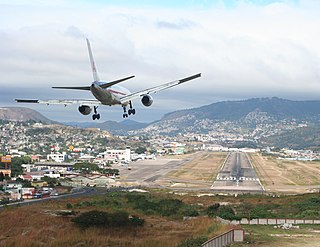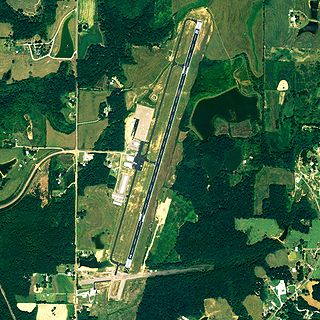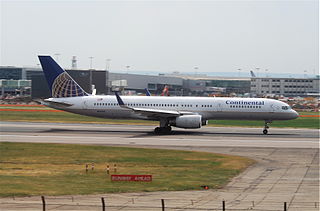
A teardrop turn is a method of reversing the course of an aircraft or vessel so that it returns on its original path, travelling in the opposite direction, and passes through a specified point on the original path. [1]

A teardrop turn is a method of reversing the course of an aircraft or vessel so that it returns on its original path, travelling in the opposite direction, and passes through a specified point on the original path. [1]

In aviation, instrument flight rules (IFR) is one of two sets of regulations governing all aspects of civil aviation aircraft operations; the other is visual flight rules (VFR).

Aerobatics is the practice of flying maneuvers involving aircraft attitudes that are not used in conventional passenger-carrying flights. The term is a portmanteau of "aerial" and "acrobatics". Aerobatics are performed in aeroplanes and gliders for training, recreation, entertainment, and sport. Additionally, some helicopters, such as the MBB Bo 105, are capable of limited aerobatic manoeuvres. An example of a fully aerobatic helicopter, capable of performing loops and rolls, is the Westland Lynx.
A man overboard rescue turn is a shiphandling manoeuvre usually implemented immediately upon learning of a person having gone overboad into the sea. To bring a vessel closer to the person's location, implementations of the principles described are: the Anderson turn, the quick turn, the Williamson turn, and the Scharnow turn.

In aviation, the instrument landing system (ILS) is a precision radio navigation system that provides short-range guidance to aircraft to allow them to approach a runway at night or in bad weather. In its original form, it allows an aircraft to approach until it is 200 feet (61 m) over the ground, within a 1⁄2 mile (800 m) of the runway. At that point the runway should be visible to the pilot; if it is not, they perform a missed approach. Bringing the aircraft this close to the runway dramatically increases the range of weather conditions in which a safe landing can be made. Other versions of the system, or "categories", have further reduced the minimum altitudes, runway visual ranges (RVRs), and transmitter and monitoring configurations designed depending on the normal expected weather patterns and airport safety requirements.

An airfield traffic pattern is a standard path followed by aircraft when taking off or landing while maintaining visual contact with the airfield.

In flight dynamics a spin is a special category of stall resulting in autorotation about the aircraft's longitudinal axis and a shallow, rotating, downward path approximately centred on a vertical axis. Spins can be entered intentionally or unintentionally, from any flight attitude if the aircraft has sufficient yaw while at the stall point. In a normal spin, the wing on the inside of the turn stalls while the outside wing remains flying. It is possible for both wings to stall, but the angle of attack of each wing, and consequently its lift and drag, are different.

A head-up display, or heads-up display, also known as a HUD or Head-up Guidance System (HGS), is any transparent display that presents data without requiring users to look away from their usual viewpoints. The origin of the name stems from a pilot being able to view information with the head positioned "up" and looking forward, instead of angled down looking at lower instruments. A HUD also has the advantage that the pilot's eyes do not need to refocus to view the outside after looking at the optically nearer instruments.
In aeronautics, a descent is any time period during air travel where an aircraft decreases altitude, and is the opposite of an ascent or climb.

A slip is an aerodynamic state where an aircraft is moving somewhat sideways as well as forward relative to the oncoming airflow or relative wind. In other words, for a conventional aircraft, the nose will be pointing in the opposite direction to the bank of the wing(s). The aircraft is not in coordinated flight and therefore is flying inefficiently.

Air combat manoeuvring is the tactical art of moving, turning and/or situating one's fighter aircraft in order to attain a position from which an attack can be made on another aircraft. Air combat manoeuvres rely on offensive and defensive basic fighter manoeuvring (BFM) to gain an advantage over an aerial opponent.

In aviation, an instrument approach or instrument approach procedure (IAP) is a series of predetermined maneuvers for the orderly transfer of an aircraft operating under instrument flight rules from the beginning of the initial approach to a landing, or to a point from which a landing may be made visually. These approaches are approved in the European Union by EASA and the respective country authorities and in the United States by the FAA or the United States Department of Defense for the military. The ICAO defines an instrument approach as, "a series of predetermined maneuvers by reference to flight instruments with specific protection from obstacles from the initial approach fix, or where applicable, from the beginning of a defined arrival route to a point from which a landing can be completed and thereafter, if landing is not completed, to a position at which holding or enroute obstacle clearance criteria apply."

Human senses are not naturally geared for the inflight environment. Pilots may experience disorientation and loss of perspective, creating illusions that range from false horizons to sensory conflict with instrument readings or the misjudging of altitude over water.
Huron County Memorial Airport is a county-owned, public-use airport located one nautical mile (1.85 km) south of the central business district of Bad Axe, a city in Huron County, Michigan, United States. It is included in the Federal Aviation Administration (FAA) National Plan of Integrated Airport Systems for 2017–2021, in which it is categorized as a local general aviation facility.

In aviation, holding is a maneuver designed to delay an aircraft already in flight while keeping it within a specified airspace.
Northeastern Regional Airport is a public use airport in Chowan County, North Carolina, United States. It is owned by the town of Edenton and located three nautical miles (6 km) southeast of its central business district. This airport is included in the National Plan of Integrated Airport Systems for 2011–2015, which categorized it as a general aviation facility.

In aeronautics, the final approach is the last leg in an aircraft's approach to landing, when the aircraft is lined up with the runway and descending for landing. In aviation radio terminology, it is often shortened to "final".
The Next Generation Air Transportation System (NextGen) is an ongoing United States Federal Aviation Administration (FAA) project to modernize the National Airspace System (NAS). The FAA began work on NextGen improvements in 2007 and plans to finish the final implementation segment by 2030. The goals of the modernization include using new technologies and procedures to increase the safety, efficiency, capacity, access, flexibility, predictability, and resilience of the NAS while reducing the environmental impact of aviation.

Cullman Regional Airport-Folsom Field is a public-use airport located five nautical miles north of the central business district of Cullman, a city in Cullman County, Alabama, United States. It is owned by the City and County of Cullman.

Continental Airlines Flight 1883 was a Boeing 757 that mistakenly landed on a taxiway at Newark Liberty International Airport on the evening of October 28, 2006. There were no reported injuries or damage, but the narrowly averted disaster was investigated by the National Transportation Safety Board, and caused the Federal Aviation Administration to reevaluate and modify air and ground safety procedures at and around Newark Airport.

United Air Lines Flight 736 was a scheduled transcontinental passenger service flown daily by United Airlines between Los Angeles and New York City. On April 21, 1958, the airliner assigned to the flight, a Douglas DC-7 with 47 on board, was flying over Clark County, Nevada in clear weather when it was involved in a daytime mid-air collision with a United States Air Force fighter jet crewed by two pilots. Both aircraft fell out of control from 21,000 feet (6,400 m) and crashed into unpopulated desert terrain southwest of Las Vegas, leaving no survivors. The loss of Flight 736, one of a series of 1950s mid-air collisions involving passenger aircraft in American skies, helped usher-in widespread improvements in air traffic control within the United States, and led to a sweeping reorganization of federal government aviation authorities.